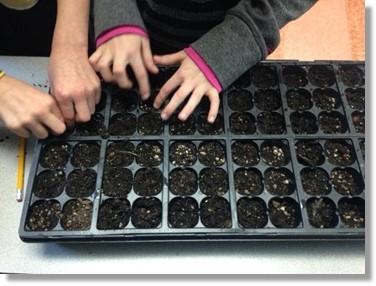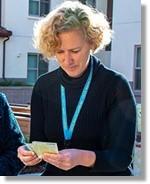Winter 2021-22
Starting Seeds Indoors is Frugal, Fun and Fascinating

by Kate Verhoef
Another new year is upon us, and so we turn our thoughts to planning our summer garden. While many of us wait until April or May to purchase vegetable seedlings at our local nurseries, there are many benefits to starting your own seeds at home indoors. First, it’s frugal. An entire packet of seeds costs about the same as one store-bought seedling in a 4-inch pot. Second, it’s fun. With a little effort, patience and attention, you can create your own indoor mini oasis. Third, it’s fascinating. Watching tiny seeds sprout and grow under your care is an amazing and rewarding experience.
Where can I get seeds?
Buy seeds from a reputable nursery. Seed catalogues are another great place to look for varieties you might not have considered. Another option is your local library. A few libraries in our county have transformed their old card catalogues into free seed libraries. Check with the library nearest you to see if they’re participating in this wonderful sustainability project. Also consider sharing seeds with your friends and neighbors. This is a great option for people who garden in small spaces or containers.

How do I know whether my seeds are viable?
The viability of seeds decreases with each passing year, so it’s best to choose seeds that have the current planting year stamped on them. Reputable nurseries and online seed catalogues will only sell viable seeds, but it’s always good to check that stamp. If you’re using old seeds from your previous year or two of gardening (or from the deep recesses of your garage), the following fun experiment will help you determine if your seeds are still viable: Dampen a paper towel. Take ten seeds and line them up near one end of the moist paper towel. Roll the towel up loosely and seal it inside a Ziploc bag to keep the contents moist. Place the bag on top of your fridge and leave it for 7-10 days, depending on the type of seed. Check for moisture every other day, but with a sealed bag this should not be a problem. Then check if the seeds have germinated. If fewer than seven of the ten have sprouted, you’re better off starting with new seeds. If between seven and nine of them have sprouted, use them but sow more of them than you need. If all ten have sprouted, you’re good to go!

What does the seed packet tell me?
Considerations such as planting depth, thinning rate, and special instructions like soaking and scarification (nicking) will be clearly stated on your seed packet. Be sure to read it carefully and follow the recommendations.
Which veggies can I start indoors?
Garden veggies such as tomatoes, peppers, broccoli, cauliflower, and eggplant are good candidates for starting indoors. Other garden favorites that can be started either indoors or in the ground are cucumbers, lettuces, melons, pumpkins, summer and winter squash, and peas. Root vegetables such as carrots, beets, and radishes should only be started in the ground.
Read on and get all your questions answered: When should I start? What kind of pots should I use? What kind of soil should I use? How do I plant them? ... and much more!
Life Expectancy of Vegetable Seeds from Iowa State University
